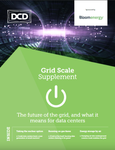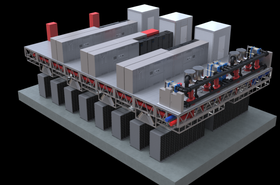Medium voltage (MV) uninterruptible power supply (UPS) and fuel cell technologies have the potential to protect the availability of and provide power to the grid, while saving energy and carbon emissions
Why are data center operators embracing green trends?
Increased environmental legislation, coupled with record-high energy prices, puts European operators under pressure. With energy experiencing a supply crisis at a time of high demand, energy-intensive businesses like data centers are eager to take more control over their energy usage. This will help them meet new legislation, maintain power continuity, and earn income from energy markets.
New UPS and fuel cell technologies can provide both power continuity and power to the grid. The technologies also allow the data center to integrate renewable energy and even generate income by participating in demand and frequency response schemes.
Using low-carbon technologies also help to build your reputation as a sustainable business.
Why is the medium-voltage level beneficial for a UPS system?
Data center UPS systems traditionally operate alongside servers and HVAC equipment at the low-voltage level. However, data center facilities are becoming larger and demanding more power to gain economies of scale. As power requirements increase, moving to medium voltage is a natural step for UPS systems. Aside from offering the two primary benefits of increased reliability and reduced costs, medium-voltage systems provide other benefits too.
Operating at 24 kV, medium-voltage equipment is significantly more robust than comparable low-voltage systems. A data center would also require fewer units to meet its power needs. As individual modules, these units are easier to install, operate, and maintain than multiple low-voltage systems spread around the facility. This reduces downtime because more equipment automatically means more risks.
The medium-voltage approach also has energy efficiency advantages as it runs lower currents, reducing electrical losses. The latest systems boast efficiency of up to 98 percent because of power conversion equipment that supports power quality continuously without requiring batteries. Evaluated against a rotary UPS, the higher medium voltage efficiency can save up to 4.2 GWh. This saving equates to 1,245 tonnes of CO2 emissions over a 15-year life for a large site.
Added benefits are achievable by using a scalable and modular MV UPS. For instance, operators can deploy up to ten ABB HiPerGuard units of 2,250 kVA in parallel to handle 22.5 MVA power. In an N+1 configuration, it’s possible to take one system offline while leaving the others in service for ease of maintenance.
Since the MV UPS operates at a medium-voltage level at the grid connection point, it’s flexible enough to support any data center loads. This flexibility ensures power continuity for servers to remain stable throughout the center by overcoming short outages and power quality concerns. In contrast, low-voltage UPS capacity can potentially become stranded when power can’t be reassigned elsewhere. This may require additional capital outlay to ensure full coverage of backup power.
Furthermore, operating at the MV level saves on additional capex, as the UPS units can be installed in an electrical room or substation rather than occupying high-value server room space. Such a location makes it ideal for feeding power back into the grid if necessary.
How can fuel cells play a role?
Many of the largest data center providers actively pursue strategies to reduce or eliminate reliance on diesel generators. For example, Microsoft has committed to ending diesel use by the end of 2030 and is already trialling fuel cells as an alternative. In 2020, Google announced a commitment to use large batteries instead of diesel gensets at a new site in Belgium.
The appeal of fuel cells lies in their potential to provide local backup power and even inject power into the grid during peak demand periods. Fuel cell technology combines materials and chemical science with automation, and protection and control systems, therefore its application requires specialist knowledge from each field.
Fuel cells can be integrated into power systems, for instance deploying 200kW installations to power electric vehicle charging stations where grid power is unavailable. Furthermore, fuel cells provide emergency backup in microgrids and power for telecoms sites at other remote locations.
However, for data centers, further investigation needs to take place at the multi-megawatt level. This requires sophisticated development and testing of the interfaces between fuel cells, energy storage systems, electrical switchgear, and control infrastructure. We need an integrated approach to data center requirements.
As a component of microgrids, fuel cells can be combined with other technologies to meet any off-grid or prosumer need. The latest offerings are available as modular 1 and 3 MW solutions, which are fast to deliver and deploy.
How can operators use backup capacity to generate income?
Operators with robust infrastructure can earn additional income and offset their costs by selling their excess power back to the grid during peak demand. This can take place through demand response schemes or using a battery energy storage system to support the integration of renewables like wind and solar.
At the end of the day, the data center’s own power needs must remain the top priority. Therefore, operators can use MV UPS systems and fuel cells to support their own servers and HVAC systems in the first instance. Only when these needs have been met can spare capacity be used for grid support.





